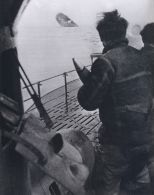

|
U-Boat Deck Gun Attacks
Due to the high rolling and pitching, a U-boat makes a poor gun platform. Furthermore, depending on wind and sea conditions, it was not always possible to man the deck guns. The U-boatís deck gun was also of no use against enemy warships, as enemy destroyers would easily outgun a U-boat anytime.

|
| U-boat crew shells a British tanker after it failed to go down with a torpedo. |
Although intended primarily as a defensive weapon, the deck gun however could be used against stragglers and unescorted merchants, and some ships, particularly tankers could be sunk at leisure, even in daylight. It was also useful in conserving the limited torpedo supply and to finish off the kill of a ship crippled by a torpedo. Later in the war, merchants were armed with makeshift guns to repel deck gun attacks by U-boats. It was still possible to attack armed merchants however, as these were frequently manned by civilians with little or no training on naval engagements.
When the deck gun was used, the gun crew had to be secured by life lines to prevent them from being washed overboard. A crew of three manned the deck gun, gunner, layer and loader. For the ammunition, a chain of men had to be setup to bring the rounds from below the deck, to the conning tower and onto the gun crew. A small watertight locker stowed near the gun held a few more rounds ready for use, providing an advantage during the first few vital seconds of engagements. This also meant that crash dives took longer than usual, as the gun had to be secured and crew rushed below deck. There were no range finders, so engagements had to be done at close range. With an experienced crew, the rate of fire was between 15 to 18 rounds per minute. Three types of ammunition could be fired; armor piercing, high explosive and star burst (flare).
In a gunnery duel, the best position for the U-boat is to be at the stern of the victim, at a distance not less than 4,000 meters. An advantage is gained from the rear because the port side guns of the victim cannot be used in retaliation and only the stern guns can be fired. Point the boat towards the target. This presents a smaller target to the enemy, and keeping the bow pointed minimizes the effects of roll and pitch which would undermine accuracy.
Lay alternate fire with the U-boatís other weapons in order suppress return fire. There is a four second interval between rounds, and while the deck gun is reloaded, open fire with a short burst of anti-aircraft rounds. If within range, small arms fire from the MG34 is very effective at suppressing return fire. Suppressive fire from the 20mm and even the 37mm anti-aircraft cannon will not sink the ship, but is used only to prevent the crews from firing back.
An attack could be aimed at the targetís bridge, waterline or weapon systems. Attacking the bridge will hinder the victimís steering ability, while attacking at the hullís waterline would quickly sink the ship. Attacks at the bows or stern will sink the ship faster compared to attacks on an even keel. Attacking the weaponís systems will hinder the victimís ability to fire back, but it takes just one unlucky shell to penetrate the U-boatís hull which will make diving impossible. Armor piercing shells are better suited to hull attacks, while high explosive could be used against other targets.
The standard procedure for opening fire is to aim at the bridge and superstructures with ten rounds of incendiary shells, in order to provide a good marking point from the resulting fire, especially during night or low visibility conditions. The 37mm anti-aircraft cannon and MG34 is fired to suppress enemy resistance. The 20mm anti-aircraft cannon is kept in readiness, and fired only on orders from the commander. Typically, it will be used when there is a jam (stoppage) in the 37mm gun or when enemy resistance is too strong.
While it is better and safer to conduct a submerged torpedo attack, sometimes a U-boat may find itself out of position for a torpedo attack. If a merchant sails at 8 knots and above, and since the maximum underwater speed of a Type VII is also 8 knots, a U-boat had to surface to run its powerful diesel engines in order to catch up with its prey. Without the element of surprise, the deck gun makes a viable alternative.
Throughout the entire engagement, the watch crew are prohibited from witnessing the attack sequence. Four watch crews are on deck, with each covering a 90 degrees arc and they had to strictly scan their respective zones for any activity. They are not allowed to watch the attack to prevent the U-boat from being surprised by a lurking enemy.



